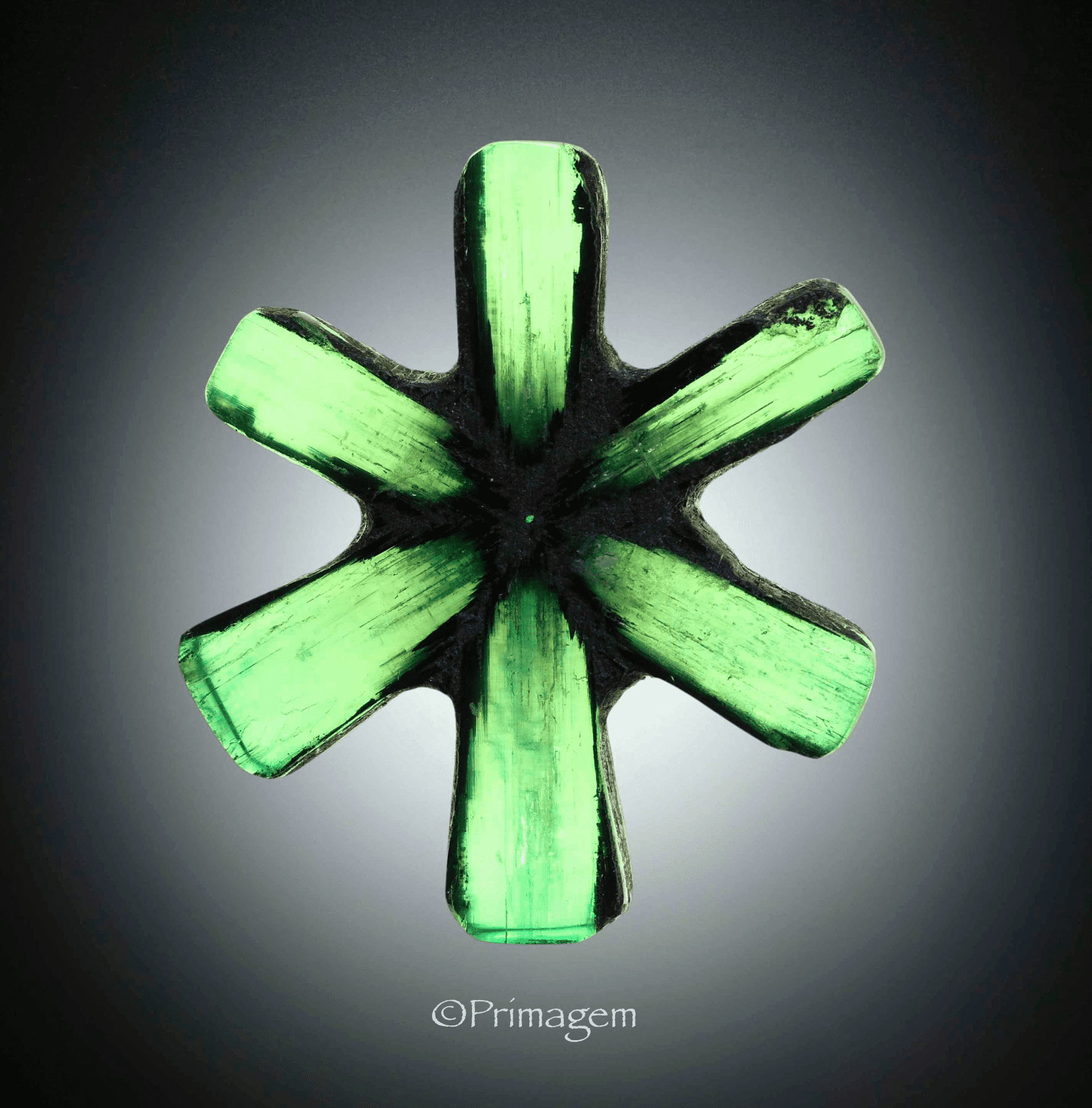What is a Trapiche Emerald?
Trapiche emerald gems are some of the world's rarest emeralds. Learn where they're found and how their characteristic “spoked wheel” patterns are formed.
2 Minute Read
What Do Trapiche Emeralds Look Like?
These emeralds get their name from the trapiche (pronounced tra·PEE·che), a grinding wheel used in Colombia, South America. In the regions where these gems are often found, people use these wheels to process sugarcane. As you can see in the following photo, some of these gems resemble a spoked wheel with a hexagonal core.
Please note, however, not all of these gems have that hexagonal "hub." Some enthusiasts believe trapiche emeralds from one mining area display the core, while those from another don't. Based on my research and conversations with dealers, the presence or lack of a core doesn't appear to indicate origin.
Interested in this topic?
This article is also a part of our Emerald Specialist Mini Course, in the unit Introduction to Emerald.
Also, keep in mind that other gemstone species — such as rubies, sapphires, and aquamarines — can occur in rare trapiche shapes.
Are Trapiche Emeralds "Star Stones?"
Despite its starlike appearance, this unique "spoked" pattern isn't a case of asterism (the "star stone" effect). However, trapiche emeralds may reveal chatoyancy, a "cat's eye" effect. Parallel growth tube inclusions can create a cat's eye in the "pie-shaped" sections as well as, rarely, along the length of whole cabbed trapiche emeralds. Expert lapidaries can orient and cut these stones to bring out this effect.
How Does a Trapiche Emerald Form?
During the formation of an emerald crystal, black carbon impurities may enter the gemstone mix. Because of emerald's hexagonal crystal structure, these impurities may fill in at the crystal junctions, forming a six-point radial pattern. In some trapiche emeralds, inclusions of albite, quartz, carbonaceous materials, or lutite may outline the hexagonal emerald core. From there, they extend in spokes that divide the surrounding emerald material into six trapezoidal sectors.
The central, tapered emerald core first grows under hydrothermal conditions, but should these conditions slow or even stop for some time, impurities may enter the mix. As growth conditions resume, both emerald and, for example, albite may form. Although the hexagonal prism faces of the core crystal can maintain their uniform growth, producing pure emerald, albite fills the areas growing from the edges, between the prism faces. This results in six sectors of clear emerald and six of a combination, predominantly albite with some emerald. Thus, the central core and the six surrounding trapezoidal sectors of a trapiche emerald comprise a single, untwinned crystal."
Although the hexagonal core may often be colorless, transparent beryl, it can also be green. In a 1970 analysis of Muzo, Colombia's trapiche emeralds in American Mineralogist, K. Nassau and K. A. Jackson found their principal coloring agent was vanadium."
Trapiche Emerald Gallery
With or without cores, trapiche emeralds make lovely gems.
Let your imagination run free when you gaze upon these precious gems. For example, in the stone below, I see a spider.
In this gem, I see a moth.
Trapiche emeralds can get very large and may even weigh several grams.
Sources of Trapiche Emeralds
People long believed only Colombia produced trapiche emeralds, at the Muzo and Peñas Blancas mines, but these gems have also been found in Brazil. Also, a light grayish green beryl, 13.74 cts, with a trapiche-like structure was discovered in Madagascar.
Trapiche Emerald Treatments
Recent visitors to the Colombian mines have reported the sale of obviously treated material presented as natural. Keep in mind that emeralds commonly receive various treatments and enhancements, and trapiche emeralds are frequently oiled or impregnated with epoxy.
You may also encounter imitation or simulated trapiches, such as a colorless beryl with a plastic coating imitating a trapiche pattern.
Marc Gering
Marc Gering has done lapidary work since the early 1990s. You can see his gems at jazzanjewels.com. He began with cabochons, then — when that wasn’t challenging enough — bought a faceting machine and taught himself the art of faceting. In the late 1990s, he turned his hobby in a different direction to patent two optics-related inventions.
International Gem Society
Related Articles
Emerald Value, Price, and Jewelry Information
Is the 500-Pound Beleza Emerald Really Worth $280 million?
The Sacred Emerald Buddha
Ethiopian Emeralds (Better than Colombian?)
Latest Articles
Morganite Buying Guide
How Do Amethysts Form?
Rhodizite Value, Price, and Jewelry Information
Pearl Treatments and Enhancements
Never Stop Learning
When you join the IGS community, you get trusted diamond & gemstone information when you need it.
Get Gemology Insights
Get started with the International Gem Society’s free guide to gemstone identification. Join our weekly newsletter & get a free copy of the Gem ID Checklist!
